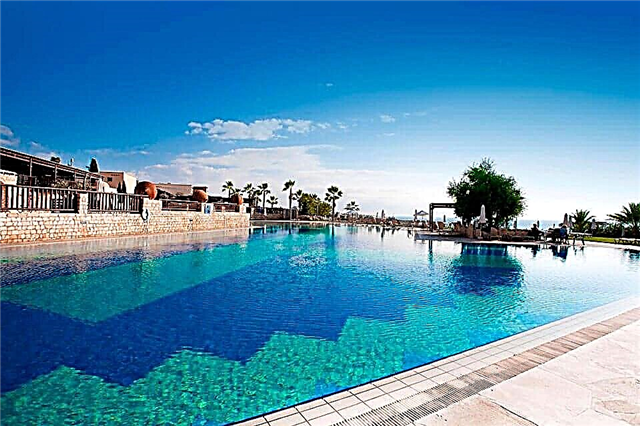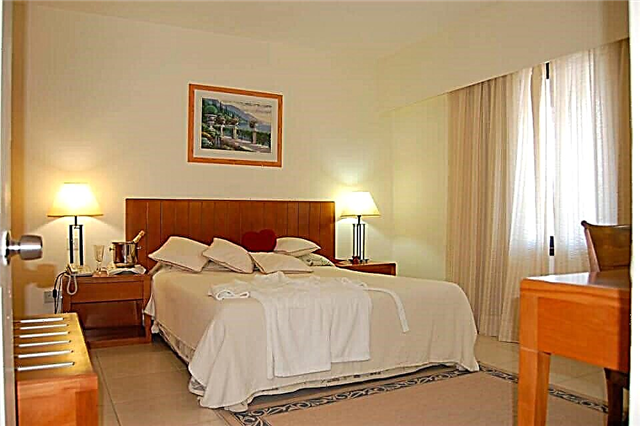Address: Russia, Yaroslavl region, Yaroslavl, Port embankment, 2
Start of construction: 1649 year
Completion of construction: 1654 year
Coordinates: 57 ° 36'41.8 "N 39 ° 54'20.5" E
Content:
The Zlatoust Church is considered a perfect and harmonious monument of ancient Yaroslavl architecture. The exquisite silhouettes of this church leave the greatest impression if you look at it from the east - from the Volga side. For a long time they served as a source of inspiration for architects and became the models on which many Russian churches were built. The multicolored ceramic trim on the altar is especially beautiful. And it is not surprising that it has become one of the visiting cards of old Yaroslavl.
History of the Church of St. John Chrysostom
In the 17th century, two stone churches were erected in the city at once, consecrated in honor of John Chrysostom. One church was built in the Kremlin, near the Assumption Cathedral. But, unfortunately, it was demolished in the 30s of the last century, during the struggle of the Soviet government with religion. So today you can see this architectural monument only in old photographs.

View of the church from the Volga
Another Zlatoust church - a summer church was built in the former Doilovoy Sloboda, which later became known as Cowsheds. The money allocated by the rich Yaroslavl residents Fedor and Ivan Nezhdanovskiy went for this. It took 5 years to build, and in 1654 the new church was consecrated. Later, both donors (benefactors) and members of their families were buried in its southern aisle.
Preserved information that soon after the construction of the temple played a major role in the life of Yaroslavl. After a terrible fire in 1658, the relics of the holy prince Fyodor Konstantinovich Cherny, the heavenly patron of the city, as well as his sons David and Constantine, were transferred from the burnt-down Savior monastery to the Zlatoust Church. And for some time they were kept in this church.
A little more than a quarter of a century has passed since the construction, and a new generation of Yaroslavl architects took up a radical alteration of the church. To make the temple better illuminated, high window openings were cut through in its main volume and decorated with elegant platbands. At the corners of the building, the builders made graceful bundles of semi-columns with colored tiled inserts. The podzakomarny roof was replaced with a more practical flat four-pitched roof. And to further emphasize the graceful lines of the temple, decorative porches were added to it, also decorated with ornaments from colored tiles and white-stone carved weights on the entrance arches.
During this reconstruction, the squat galleries were laid with bricks. Here Yaroslavl masters showed great imagination and diligence. They decorated the laid openings with lush brick platbands, the patterns of which are not repeated anywhere, and the church facades were decorated with a multicolored palette of tiled inserts. The quality and beauty of the curly masonry testifies to the high skill of the masons working at that time. This alteration gave the church an elegant and festive look, making it one of the most beautiful churches not only in the city, but also in Russia.

Platband on the altar
For a long time, the parishioners could not raise the necessary funds to decorate the church from the inside. Therefore, the walls were painted only in 1732-1733 by the efforts of the famous Yaroslavl banner maker, that is, a highly skilled master, Alexei Soplyakov, together with an artel of local icon painters. Although this painting was done at a time when the Baroque style was in its prime in Russia, the Yaroslavl residents performed more than 500 subject hallmarks in the old icon-painting traditions.
In the paintings created by Soplyakov, art critics note a special enlightened range of light, with almost watercolor undertones, as well as an impeccable composition. It is known that in 1863 the temple painting was renovated using the glue technique. And in the 60s of the last century, the wall painting was restored by a team of Yaroslavl masters, under the leadership of V.I. Vasin.
In the late 19th - early 20th centuries, a parish school, trusteeship and a library with a reading room were opened at the church. The rare works of the famous Russian photographer Sergei Mikhailovich Prokudin-Gorsky, made by him in 1911, brought to us the appearance of the Church of St. John Chrysostom at the beginning of the 20th century. In color photographs, the temple appears with whitewashed walls, on which red-brick decorative elements and colored tiles stand out in contrast. A real fairy tale in stone!
The church was closed in 1935 and its premises were used as warehouses. Unfortunately, after several years of storage inside the temple of salt, some of the frescoes on its walls were irretrievably lost. In 1992, the church was transferred to the jurisdiction of the Russian Old Believers Church, which was engaged in its restoration.

View of the church from the north-west
Architecture and interior decoration of the Church of St. John Chrysostom
The special architecture of the Church of Zlatoust is a direct evidence of the church reform carried out by Patriarch Nikon, which strictly regulated the canons of temple buildings. The four-pillar, five-domed church is surrounded by traditional side-altars and a three-sided one-story gallery, but has no basement. The Church of St. John Chrysostom became the first Yaroslavl religious building, built without the traditional ground floor, and this marked the beginning of a new architectural tradition. An innovation was also the removal of the winter, warm side-chapel and bell tower in separate buildings. Thanks to this decision, the composition of the church became strictly symmetrical.
To compensate for the relatively low size of the quadrangle, devoid of a basement, the architects made this church a powerful expressive five-domed, directed towards the sky. The size of the central drum and the head installed on it before the beginning of the cross even exceeds the height of the base of the temple.
Outwardly, the church resembles a helmet or kokoshnik, typical of ancient Russian architecture. And strict proportions give it integrity and solidity. The builders clearly hoped that the travelers, sailing past the temple on ships on the Volga, would be impressed by it. And they were not wrong!
Throughout its history, the temple has undergone many alterations. Initially, the gallery around it was open, but then its openings were covered with bricks. In the masonry, the powerful pillars of the former arcade are clearly distinguishable. On the east side, the gallery ends with symmetrical side-chapels with hipped roofs.
At first glance, it seems that the church facade is not well decorated. However, from afar, from the side of the river, all the details of the cornice, basement, faceted half-columns and window frames on the side altar apses are clearly visible on it, all made of brick. Tent side-chapels dedicated to the Conception of John the Baptist and the Holy Equal-to-the-Apostles Princess Olga are also modestly and at the same time very elegantly decorated with rows of small kokoshniks.

Church domes
But the most remarkable element of the decoration of the Zlatoust Church is the amazingly beautiful platband on the window of the central altar apse, made of multicolored glazed ceramics. It is known that it was made forty years after the construction of the church. The platband has an impressive size - 8 by 5 m and is considered by all art critics to be an unsurpassed masterpiece. There is no such miracle anywhere else in Russia!
Colored tiles have become a real hallmark of Yaroslavl architecture of the 17th century. They were made using a complex technology from special red clay on wooden blocks, and then fired. The tiles were covered with five-color glaze and used in them traditional ornaments and plots - stylized flowers and leaves, images of a unicorn, a Sirin bird, a nightingale and a griffin.
Inside the church, a unique carved iconostasis has been preserved, made by Yaroslavl craftsmen in the late 17th - early 18th centuries. Experts consider it a real masterpiece of arts and crafts. The five-tiered iconostasis is decorated with intricate baroque ornaments in the form of vines and garlands of flowers. And on the Royal Doors, a carved composition imitating a blooming sunflower is reproduced. Most of the images for this iconostasis were painted at the same time - in the 17th and 18th centuries. And some of the icons were created by the talented iconographer Semyon Kholmogorets. The most valuable of them are carefully kept in the collections of the Yaroslavl Museum-Reserve.
The current state of the temple and the visiting regime
Now the church is used for Old Believer services, and at the same time restoration work is being carried out in it. It is not easy to get inside the temple, especially for ordinary tourists.

Fragment of the church wall
How to get to the Church of St. John Chrysostom
The church is located in Yaroslavl on Portovaya embankment, 2, next to the bank of the Volga.
By car. The federal highway M8 leads from Moscow to Yaroslavl. Within the city limits, it is called Moskovsky Prospekt. Before reaching the bridge over the Korotosl River, you need to turn right from it - onto Malaya Proletarskaya Street. Along it, as well as along the streets of Melnichnaya and Zlatoustinskaya after 1.7 km, you can go to the temple.
By train. From Moscow to Yaroslavl, express train trains reach in 3 hours 16 minutes. The journey by regular train takes from 4 to 5.5 hours. From Moskovsky Train Station in Yaroslavl, the distance to the Annunciation Church is 2.7 km. You can walk to it or take a taxi.











